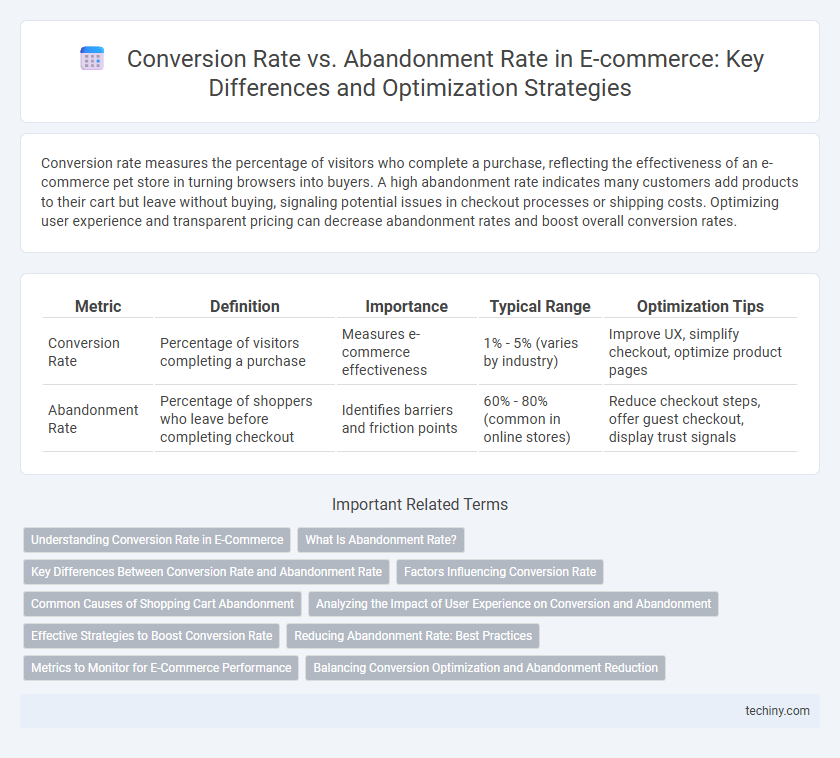Conversion rate measures the percentage of visitors who complete a purchase, reflecting the effectiveness of an e-commerce pet store in turning browsers into buyers. A high abandonment rate indicates many customers add products to their cart but leave without buying, signaling potential issues in checkout processes or shipping costs. Optimizing user experience and transparent pricing can decrease abandonment rates and boost overall conversion rates.
Table of Comparison
| Metric | Definition | Importance | Typical Range | Optimization Tips |
|---|---|---|---|---|
| Conversion Rate | Percentage of visitors completing a purchase | Measures e-commerce effectiveness | 1% - 5% (varies by industry) | Improve UX, simplify checkout, optimize product pages |
| Abandonment Rate | Percentage of shoppers who leave before completing checkout | Identifies barriers and friction points | 60% - 80% (common in online stores) | Reduce checkout steps, offer guest checkout, display trust signals |
Understanding Conversion Rate in E-Commerce
Conversion rate in e-commerce measures the percentage of visitors who complete a desired action, such as making a purchase, and is a critical indicator of website effectiveness and customer engagement. Optimizing user experience, product presentation, and checkout processes directly influences this rate, driving higher sales and revenue. Lowering the abandonment rate, which represents the percentage of users who leave without completing the transaction, is essential for improving overall conversion performance.
What Is Abandonment Rate?
Abandonment rate in e-commerce measures the percentage of shoppers who add items to their cart but leave the site before completing the purchase. It reflects potential lost sales opportunities and highlights friction points in the checkout process. Tracking abandonment rate helps businesses identify and resolve issues that hinder conversion rates, ultimately improving overall revenue.
Key Differences Between Conversion Rate and Abandonment Rate
Conversion rate measures the percentage of visitors who complete a desired action, such as making a purchase, while abandonment rate tracks the percentage of users leaving a process like the checkout before completion. A high conversion rate signifies effective user engagement and successful sales funnel optimization, whereas a high abandonment rate indicates potential issues in user experience or payment processes. Analyzing both metrics helps e-commerce businesses identify barriers to purchase and optimize strategies to increase sales and reduce dropout.
Factors Influencing Conversion Rate
Conversion rate in e-commerce is significantly influenced by website usability, including fast load times, intuitive navigation, and mobile responsiveness, which enhance user experience. Product presentation, such as high-quality images, detailed descriptions, and customer reviews, directly impacts buyer confidence and decision-making. Trust signals like secure payment options, clear return policies, and visible contact information also play crucial roles in reducing cart abandonment and increasing conversion rates.
Common Causes of Shopping Cart Abandonment
High shopping cart abandonment rates in e-commerce often result from unexpected shipping costs, complicated checkout processes, and lack of payment options. Slow website loading times and mandatory account creation also contribute significantly to potential customers leaving without completing purchases. Optimizing user experience by simplifying checkout steps and providing transparent pricing can improve conversion rates and reduce abandonment.
Analyzing the Impact of User Experience on Conversion and Abandonment
Improving user experience directly boosts e-commerce conversion rates by streamlining navigation, simplifying checkout processes, and enhancing site speed, which reduces friction points that often lead to cart abandonment. Data shows that sites with optimized user interfaces achieve up to a 30% higher conversion rate while simultaneously lowering abandonment rates by 20%. Focusing on responsive design, personalized content, and clear calls-to-action significantly impacts the purchase decision, minimizing drop-offs during critical stages of the customer journey.
Effective Strategies to Boost Conversion Rate
Optimizing product pages with clear calls-to-action and fast load times significantly boosts the conversion rate by reducing friction during the checkout process. Implementing personalized email campaigns and retargeting ads effectively re-engages potential customers who have shown interest but abandoned their carts. Streamlining payment options and providing transparent shipping information decreases abandonment rates, directly contributing to higher overall sales performance in e-commerce.
Reducing Abandonment Rate: Best Practices
Reducing abandonment rate in e-commerce significantly boosts conversion rate by addressing key friction points such as complicated checkout processes, unexpected shipping costs, and lack of payment options. Implementing strategies like simplified navigation, transparent pricing, and multiple secure payment methods directly decreases cart abandonment. Optimizing page load speeds and offering real-time customer support further enhances user experience, encouraging shoppers to complete purchases consistently.
Metrics to Monitor for E-Commerce Performance
Conversion rate and abandonment rate are critical metrics to monitor for e-commerce performance, reflecting customer engagement and purchase intent. High conversion rates indicate successful sales tactics, while elevated abandonment rates signal potential issues in the checkout process or user experience. Tracking these metrics alongside average order value and bounce rate enables data-driven optimization of marketing strategies and website functionality.
Balancing Conversion Optimization and Abandonment Reduction
Balancing conversion rate optimization and abandonment rate reduction requires a strategic approach that enhances user experience while addressing key friction points in the checkout process. Implementing tools like streamlined payment options, personalized recommendations, and real-time customer support can significantly increase conversion rates and simultaneously lower cart abandonment rates. Data-driven analysis of user behavior and A/B testing ensures continuous improvement in converting visitors into buyers without overwhelming them.
Conversion Rate vs Abandonment Rate Infographic

 techiny.com
techiny.com